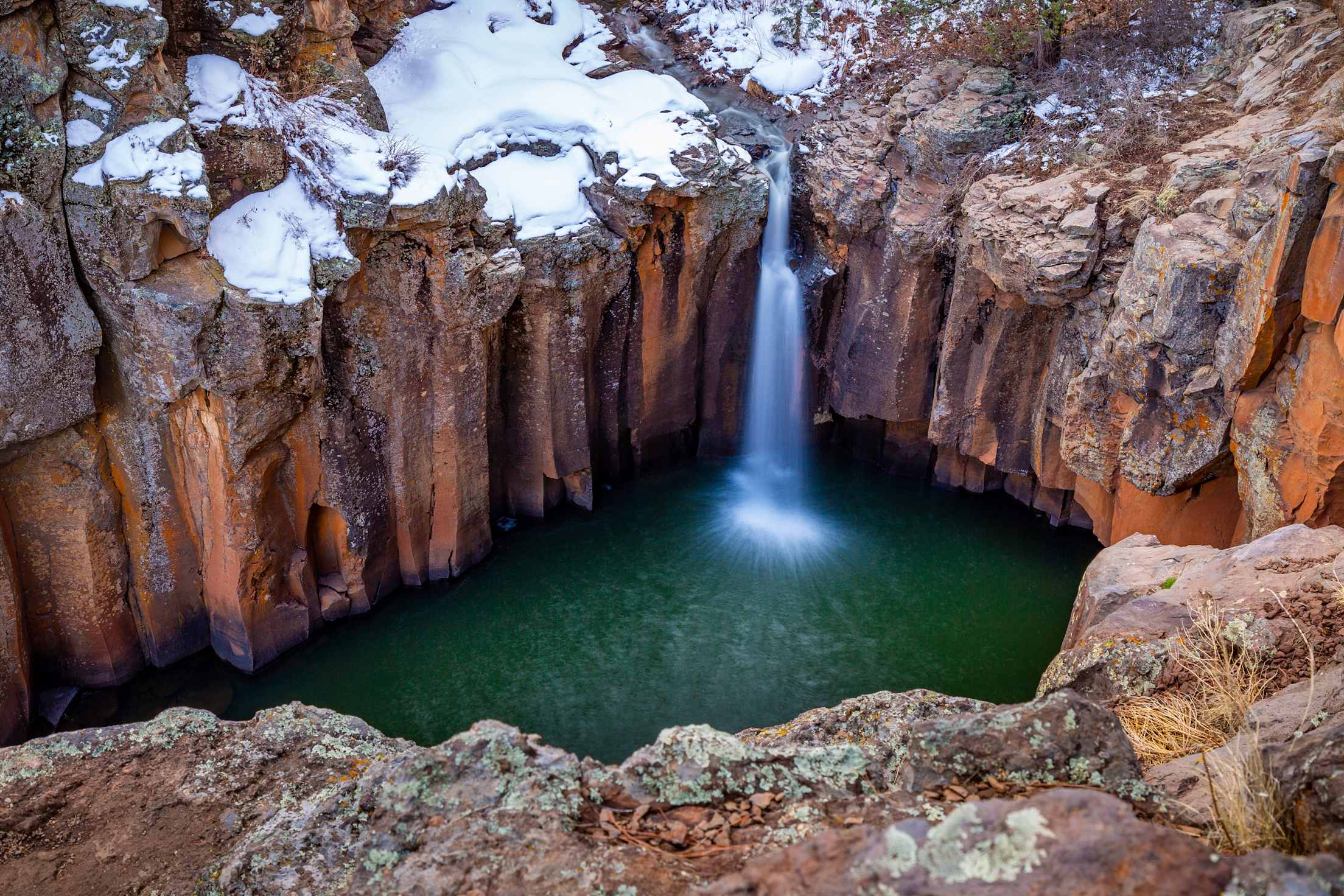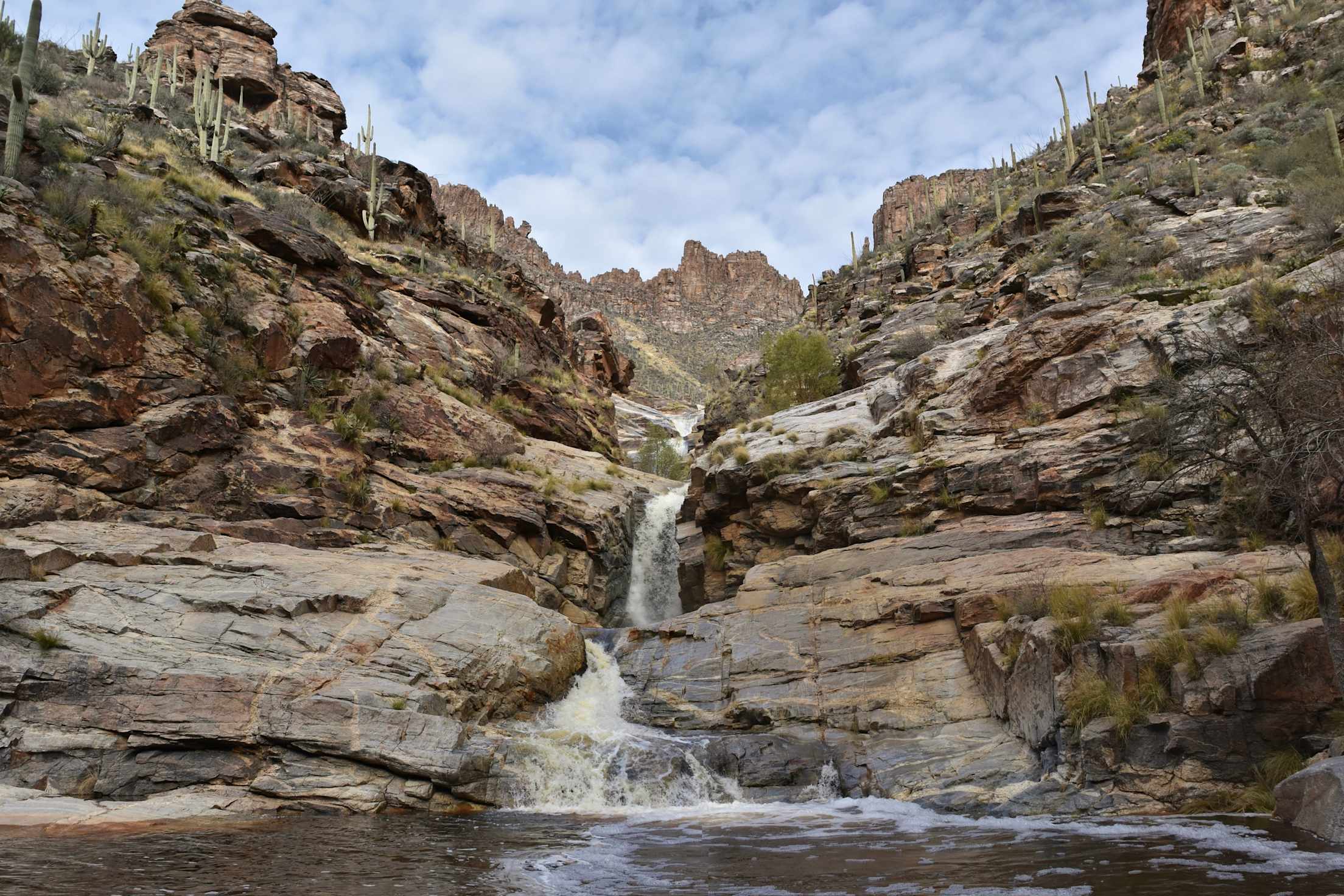
Arizona's Best Waterfalls
Chase rushing cascades at these 5 spots.

Yes, the Grand Canyon State is famous for its sunshine, saguaros, and parched Sonoran landscapes, but that only makes Arizona’s waterfalls that much more wondrous and awe-inspiring. Here, your guide to five incredible cascades, from iconic to unsung.
Havasu Falls
A roaring cataract pouring from a monumental rust-red cliff, splashing into an impossibly turquoise pool, Havasu Falls is the stuff that dreams are made on. The Havasupai people have been living and dreaming near the waterfall for over a millennium; in fact, the tribe’s name means “people of the blue-green waters.” Nestled deep in the Grand Canyon, the 90-foot gusher is as remote as it is beautiful—and requires herculean effort to reach. To visit the falls, travelers must secure a permit, plus three nights of lodging in the canyon (reservations typically fill the first day they become available on the tribe’s website), then prepare for a steep, 20-mile round-trip hike. All that effort pays off the moment you finally catch sight of the mesmerizing blue-green water. Once it hits the canyon floor, the water flows into a series of travertine terraces, forming pools—each one an ideal spot from which to soak and marvel at the gorgeous surrounds. Note: At the time of publication the Havasupai Reservation has temporarily suspended tourism. The Tribal Council is consulting with health experts to determine when and if the Havasupai people will reopen their land to tourists.

Sycamore Falls
With sunlit meadows, fragrant ponderosa woodlands, and towering canyon walls carved from rainbow-hued Mesozoic rock, Sycamore Canyon might just be the most beautiful Arizona canyon you’ve never heard of. At more than 50,000 acres, Sycamore is the second largest canyon in red rock country, smaller only than its superstar sibling, Oak Creek. But flying under the radar can be a good thing: In this case, you’ll find that when you drive up to Williams after a snowy winter or a heavy monsoon storm, you’ll have less competition for the view of Sycamore Falls. For easy trailhead access, take I-40 to Forest Road #141, continue south to Forest Road #56, and follow that 1.5 miles to the trail parking lot. From there, the hike to the viewpoint is less than a quarter-mile. Up for a day hike? Tackle the 11-mile Sycamore Rim Trail, which delivers bird’s-eye views of the area’s cliffs, canyons, and streams. (Look for javelina, deer, and ringtail cats along the way, particularly in early morning and late evening.) The falls itself is a sight to behold: the walls framing the waterfall are so immense, the 70-foot cascade looks tiny.

Cibecue Falls
Visiting Cibecue Falls is no casual day trip. This 80-foot cataract, hidden in a side canyon of the Salt River on the Fort Apache Reservation, takes serious commitment to reach. First, you’ll need a permit to hike in the area, available for purchase from the Arizona Sportsman's Warehouse in Tucson, or at Carrizo Service Station, located at the junction of Highways 60 and 73, northeast of the trailhead leading to the falls. If you plan to hike beyond the first waterfall to the second and third falls, you’ll also need a guide. (The White Mountain Apache Game & Fish Department, which can be reached at (928) 338-4385, can provide suggestions.) Then, with those prerequisites settled, you’ll drive a narrow, bouncy dirt road to reach the trailhead. The 2-mile path begins along the banks of Cibecue Creek, before quickly plunging right into the stream. Massive canyon walls soar overhead as you sloosh through the water to reach the milky white cascade, which spills down the rust-red cliff before you. Resist the temptation to jump in; swimming is not allowed here. The falls hit peak flow with the monsoon rains in July, but flash flooding can be a concern when rains are heavy. When that’s the case, the t-ribe will shut down the trail to the falls.

Seven Falls
While most Arizona waterfalls are remote, Seven Falls is remarkable for its proximity. No sooner have you passed beyond the spa, mansions, and a golf course in Tucson’s Catalina Foothills than you reach the entrance to Sabino Canyon Recreation Area, home to the beautiful seasonal waterfall. Bear Canyon Trail, the path leading to Seven Falls, winds along the canyon floor, amidst saguaros, prickly pear, and—come spring—gold poppies and purple lupine. Like many places around southern Arizona, this area is a magnet for birds. Keep a sharp eye out along the trail, and you might be rewarded with a sighting of a black-chinned hummingbird, a Gambel’s quail, or even a greater roadrunner. At mile 4, you’ll reach the falls: multi-tiered, ribbon-like cascades flowing with Santa Catalina Mountain snowmelt. (The falls are dependent on snowmelt and heavy rains to run, so time your visit accordingly.) Given the canyon’s proximity to Tucson, the parking lot fills quickly; arrive before 9 a.m. (ideally on a weekday) to snag a spot.

Grand Falls
When it comes to origin stories, it’s pretty hard to beat Grand Falls. Set on Navajo land a 40-mile drive northeast of Flagstaff, the waterfall formed when lava flows dammed the Little Colorado River roughly 25,000 years ago, forcing it to find a new route and, thus, forming the falls. But that isn’t the only thing that’s unusual about Grand Falls. The Little Colorado River starts high up in the White Mountains, then flows through the Painted Desert, picking up brown and red silt along the way. The result? At peak flow, Grand Falls takes on a russet hue, earning the broad, terraced 185-foot-high cascade the nickname “Chocolate Falls.” The falls looks all the more surreal in its lonesome high desert setting, with little growing around it besides sagebrush, tumbleweeds, and the occasional patch of grass. Grand Falls runs seasonally, depending on snowmelt and monsoon rains, so check the USGS website for streamflow conditions. When the reading for the Little Colorado River near Winslow hits 400 cubic feet per second and above, that’s when you can see the falls flowing at its finest—and, if you’re lucky, catch sight of rainbows in the mist.